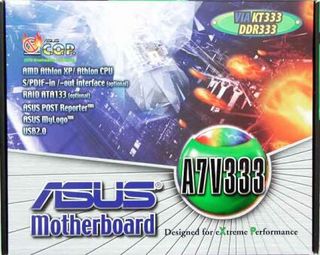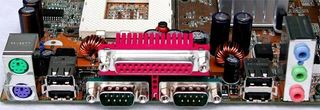VIA KT333 Put To The Test: 18 Motherboards Compared
Asus A7V333: Thermal Protection And Jumper Overkill

The Asus A7V333.

The Asus A7V333's retail package.
Still a market leader in the motherboard sector, Asus sent its A7V333 to the test. In the package are various slot panels with FireWire, USB and game ports. The user guide offers an overview of all the board functions as well as jumper and BIOS settings. With over 36 jumpers, the well-designed motherboard is not exactly one of the most user-friendly candidates. The 30 mm high passive Northbridge cooler provides sufficient cooling. Some of the positive features are integrated functions such as FireWire (TI TSB43AB21, IEEE1394), the Promise RAID controller (PDC20276), and the six-channel PCI sound (C3DX CMI3738). Along with the Soltek SL-75DRV5, the Asus A7V333 has perfect thermal protection: it's even possible to remove the cooler during operation without causing the AMD Athlon XP to burn up. What wasn't so positive is that Asus still tries to push its way to the top of the benchmark tests by cranking up the FSB clock up to 135 MHz, instead of leaving it at 133 MHz according to specification.

A view of the interfaces on the Asus A7V333.

Chips for sound and USB on the Asus A7V333.
In order to make this a fair comparison, Asus gave us an adapted BIOS (version 6b Beta 004), which decreases the FSB clock to its proper 133.33 MHz. The boards that are available in retail stores with the BIOS versions available on the Internet only run at 135 MHz. The manufacturer doesn't give another thought to this, though, and so it offers a full guarantee "for factory overclocking." With regard to overall performance, this board takes fourth place, but note that this is using the standard clock speed. As usual, the Asus board is a bit more expensive (about $175), even though its features are quite sparse compared to its rivals.

Items included with the Asus A7V333.
Stay on the Cutting Edge
Join the experts who read Tom's Hardware for the inside track on enthusiast PC tech news — and have for over 25 years. We'll send breaking news and in-depth reviews of CPUs, GPUs, AI, maker hardware and more straight to your inbox.
Current page: Asus A7V333: Thermal Protection And Jumper Overkill
Prev Page Acorp 7KT333: A Classic OEM Product Next Page Aopen AK77-333: Not Feature-RichMost Popular

